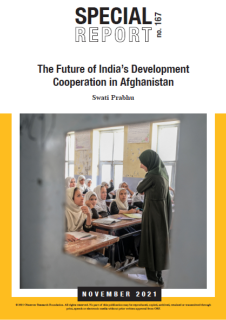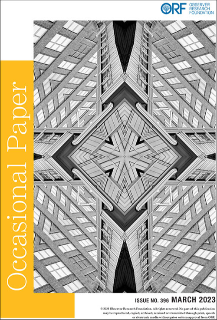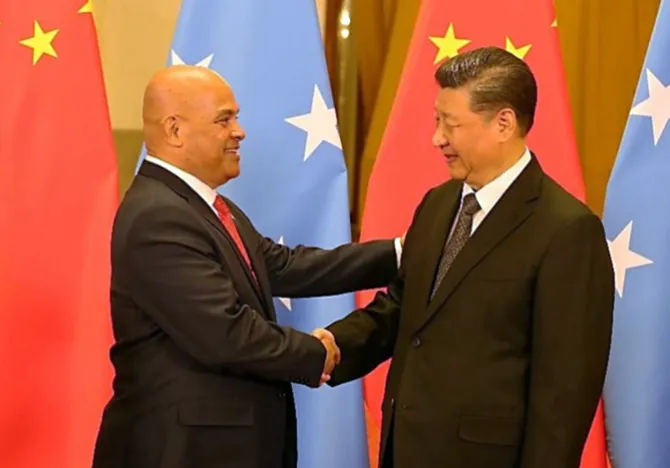
For the first time since the end of World War II, Oceania has regained its strategic significance. The vast region encompassing Melanesia, Micronesia, Polynesia, and Australasia, constitutes 16 countries, some of which have the world’s largest exclusive economic zones (EEZs) because of the region’s island geography. The Blue Pacific Continent is also a trove of unexplored blue economy sources and natural deep-sea ports. In recent years, the United States (US), Australia, Japan, New Zealand, France, and Taiwan have intensified their engagement in the region, partly in response to China's growing interest in the area. Beijing's collaborative efforts in the region highlight a potent two-pronged strategy, comprising diplomatic and economic engagement. This article focuses on Chinese investments in the Micronesian and Polynesian regions and their strategic and geoeconomic implications.
Chinese loans and investments in Micronesia and Polynesia
On 1 January 2020, Kiribati became the 10th Pacific Island country (PIC) to join the Belt and Road Initiative (BRI), Beijing’s transnational infrastructure and connectivity initiative. Kiribati followed Samoa, the Federated States of Micronesia (FSM), Tonga and Niue which joined the BRI in 2019. During the Second Belt and Road Forum held in 2019, Chinese government officials promised the PICs developmental aid worth millions of dollars, along with assistance from Chinese state and private companies in the construction of developmental infrastructure.
Table 1. Major Chinese projects in Micronesia and Polynesia (2017-22)
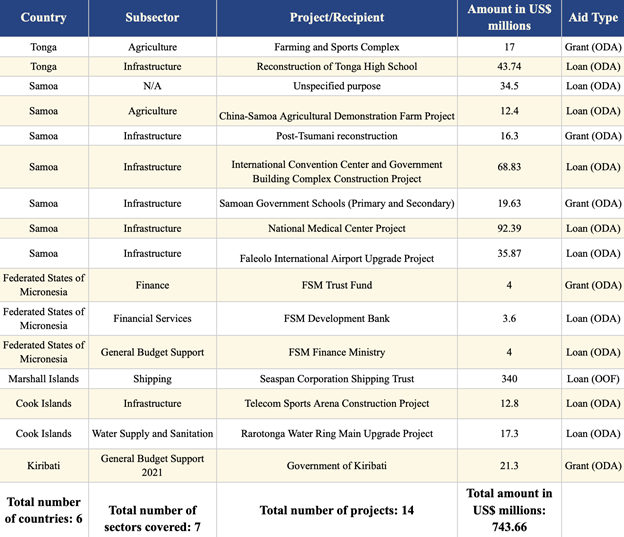
Source: Collated data from China’s National Development and Reform Commission, AidData, China State Council, AEI China Global Investment Tracker
To that effect, between 2013-2023, China invested in Samoa (US$ 2.34 billion), FSM (US$ 2 billion), Marshall Islands (US$ 1.7 billion), Kiribati (US$ 1.19 billion) and Cook Islands (US$ 0.5 billion). Chinese aid and investments spanned several economic sectors in these countries, as shown in Table 1. Beijing’s state-owned corporations have built roads, railways, airport strips, social infrastructure (schools, hospitals, affordable housing), and renewable energy infrastructure worth US$ 1 billion across the breadth of the Polynesian and Micronesian islands. Chinese tech companies such as Huawei, Tencent, and Alibaba have also endeavoured to further digital connectivity in the region by building 5G capacity in these nations, laying undersea cables and giving their respective governments access to high-tech surveillance hardware.
However, participation in Beijing’s BRI and the developmental aid attached therein comes with its caveat. In 2009, the Pacific Island nations constituted a third of the countries that recognised Taiwan as the Republic of China. Craftily enough, in 2018 and 2019, Beijing convinced Tonga, Samoa, FSM, and Kiribati to join the BRI and cut off diplomatic ties with Taiwan. In turn, Chinese state-owned corporations flooded these nations with investments. Beijing is also courting these islands for their abundant EEZs: Kiribati has the world’s largest EEZ (3.5 million square miles) and Micronesia’s EEZ is three times larger than that of China. These EEZs are troves of unexplored blue economy sources, especially fish. China has obtained fishing licensing in the Blue Pacific continent’s abundant waters. Between 2016 and 2022, Chinese-flagged distant sea fishing vessels in the South Pacific have grown from 245 to 476, more than tenfold from 46 in 2009. China’s deep-sea fleet is considered the world’s most flagrant offender of illegal, unregulated and unreported fishing. Its squid haul in the region has grown from 42,000 tons in 2012 to 422,000 tons in 2022; while its overall fishing haul in the region grew by 430 percent between 2014 and 2022. The scale has triggered fears concerning damage to the island economies and the marine ecosystem, as well as the commercial sustainability of tuna, squid, and other species. Yet, governments are reluctant to interfere as Chinese developmental aid constitutes a major chunk of their international developmental aid.
Beijing’s Positive Economic Statecraft (PES) in Micronesia and Polynesia
The quid pro quo relationship between China and the Pacific Island states wherein Beijing influences the latter’s policy imperatives and influences their government’s behaviour through positive economic endowments such as import duty concessions, developmental aid, concessional loans and infrastructure development is a prime instance of China’s PES. However, besides these conventional instruments of PES, China has also signed numerous Economic and Technical Cooperation Agreements (ETCAs) with these six island countries. Under these ETCAs, Beijing has allocated funds for furthering local capacity-building and development in eight economic sectors. Chinese ETCAs between 2017 and 2022 amounted to US$ 385 million.
The quid pro quo relationship between China and the Pacific Island states wherein Beijing influences the latter’s policy imperatives and influences their government’s behaviour through positive economic endowments such as import duty concessions, developmental aid, concessional loans and infrastructure development is a prime instance of China’s PES.
Table 2. Chinese ETCAs with Micronesian and Polynesian countries between 2017-2022
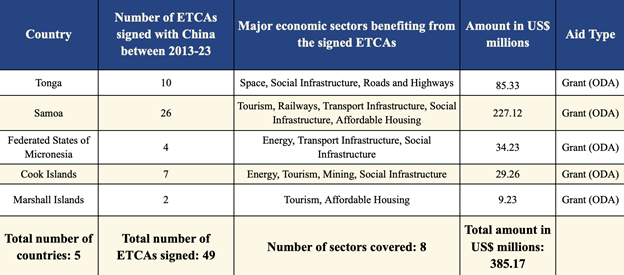
Source: AidData
Prima facie, these ETCAs have augured economic growth and aided social protection programmes in the broader South Pacific region. However, there are some high-value ETCAs wherein funds are allocated for ‘unspecified purposes’. These opaque ETCAs mask Beijing’s tactical manoeuvring to achieve its strategic imperatives in the region. For instance, in 2017 China signed an ETCA with Samoa which allocated US$ 17.4 million to Samoa for ‘unspecified purposes’. Later in 2020, an investigation conducted at the behest of the Samoan Parliament, revealed that the funds granted under the supposed ETCA were allocated for conducting preliminary research on the viability of a China-funded multi-use deep-sea port. The port was eventually scrapped in 2021, due to pressures from the US, Australia and New Zealand. More recently, in May 2023 former FSM Prime Minister David Panuello alleged in a letter to the Micronesian Parliament that Chinese officials bribed elected representatives of the federal government of FSM in 2017. Coincidentally, China also signed an ETCA with FSM in the same year, wherein the funds were allocated for ‘unspecified purposes’. FSM has also accused Beijing of espionage in the vast EEZs of its islands and spying on anti-China proponents in the country.
The US, Australia and their allies must ‘step up’ their ante and aid in the region to deliver developmental aid in a more meaningful and concrete manner, lest they lose their strategic influence in the region to Beijing’s economic statecraft.
Conclusion
China has emerged as a controversial yet significant partner in the Micronesian and Polynesian regions. It has ramped up its collaborative efforts in the regions, as they are critical to China’s rise as a global power. Together, the Blue Pacific continent constitutes a major vote bank in multilateral fora, where their support is essential for China to tackle issues such as Taiwan, Hong Kong and Xinjiang human rights violations. Moreover, the Polynesian and Micronesian regions have some of the world’s most strategically located islands. For instance, Kiribati straddles the equator and the 180-degree longitude and lies at the true geographic centre of the Pacific Ocean. More recently, China has turned its attention to reaping economic benefits by delving into the untapped blue economy resources in the region. On all three counts, China has leapt bounds. Only four of the 16 Pacific Island countries recognise Taiwan today and Beijing almost succeeded in building a port with the Government of Kiribati and continues to deepen bilateral engagement with the region’s countries. The US, Australia and their allies must ‘step up’ their ante and aid in the region to deliver developmental aid in a more meaningful and concrete manner, lest they lose their strategic influence in the region to Beijing’s economic statecraft.
Prithvi Gupta works as a Junior Fellow in the Strategic Studies Programme.
The views expressed above belong to the author(s). ORF research and analyses now available on Telegram! Click here to access our curated content — blogs, longforms and interviews.






 PREV
PREV

